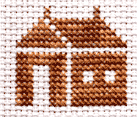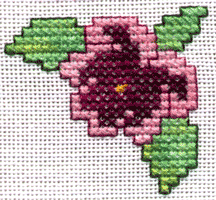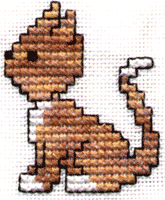Using hand-dyed threads
How many times have you been tempted by a dazzling array of multi-coloured, overdyed threads, but hesitated to buy any because you were not sure how or when to use them?
After this online workshop you need hesitate no longer. You will find it is easy to get wonderful results with the minimum of effort! Changes in colour and tone are possible without having to constantly rethread your needle. I hope you enjoy working along with me in this web class.
Cross stitch can be worked in a number of ways to take advantage of the nature of these threads. They can also be used, of course, for other needlework techniques including hardanger, blackwork and needlepoint. By stitching the little house you can try out different methods and compare the results.
The threads I have used in my samples are hand-dyed in England by Oliver Twists. The six strand cotton is familiar to most cross stitchers so I have used this to stitch our little house. Two strands of cotton are used throughout the design and we will stitch each section in a different way. You can of course use any fibres that you have handy.
 1. Lets start with the wall with windows. 1. Lets start with the wall with windows.
Cut a length of cotton and separate two strands. Put the cut end of one length next to the skein end of the other length so that the differently coloured areas do not match up exactly. Stitch this section of your house by working the continental way (i.e work the first half of each cross stitch in one direction, then come back and finish off the stitches on the return journey).
Result: You should find that this method of stitching will produce a mottled, tweedy effect with no areas of distinct colour.
 Uses: I have worked the leaves of my pansy in this manner and if you look carefully at the top left leaf you will be able to see where the second half of the cross is a different shade to the first. Ideal for giving a natural look to foliage, fields, tree bark etc. Or texture to a teddy bear's fur, etc. Uses: I have worked the leaves of my pansy in this manner and if you look carefully at the top left leaf you will be able to see where the second half of the cross is a different shade to the first. Ideal for giving a natural look to foliage, fields, tree bark etc. Or texture to a teddy bear's fur, etc.
Sections 2 and 3.
For the small roof section and wall with door we will work in a different way. Recombine two strands, as they come off the skein, so that the cut ends are together. Use the English method of stitching by completing each stitch in turn. Work in horizontal rows on the roof and vertical on the wall.
Result: You may find that working in this way will produce stripes of colour. This effect may not be too visible in these areas due to their small size. On larger areas these stripes may meet up on successive rows to form random areas or blocks of colour.
 Uses: Used carefully this method can be great for animals with stripy coats. But make sure you have the stripes going in the right direction (not like those on our poor kitty's head)! Perhaps you could also use it to add pattern to a figures' clothes (i.e. a stripey dress). Uses: Used carefully this method can be great for animals with stripy coats. But make sure you have the stripes going in the right direction (not like those on our poor kitty's head)! Perhaps you could also use it to add pattern to a figures' clothes (i.e. a stripey dress).
Contd. on page 2
|